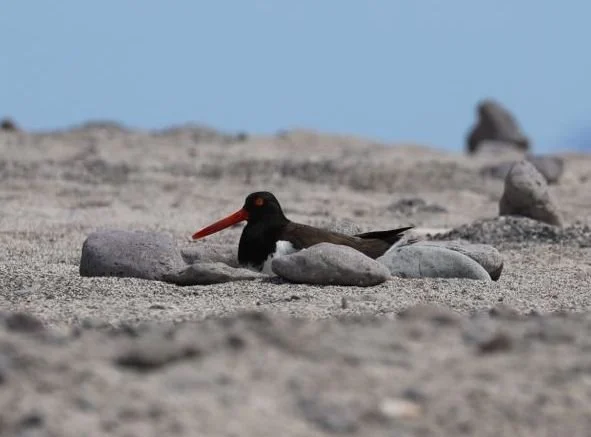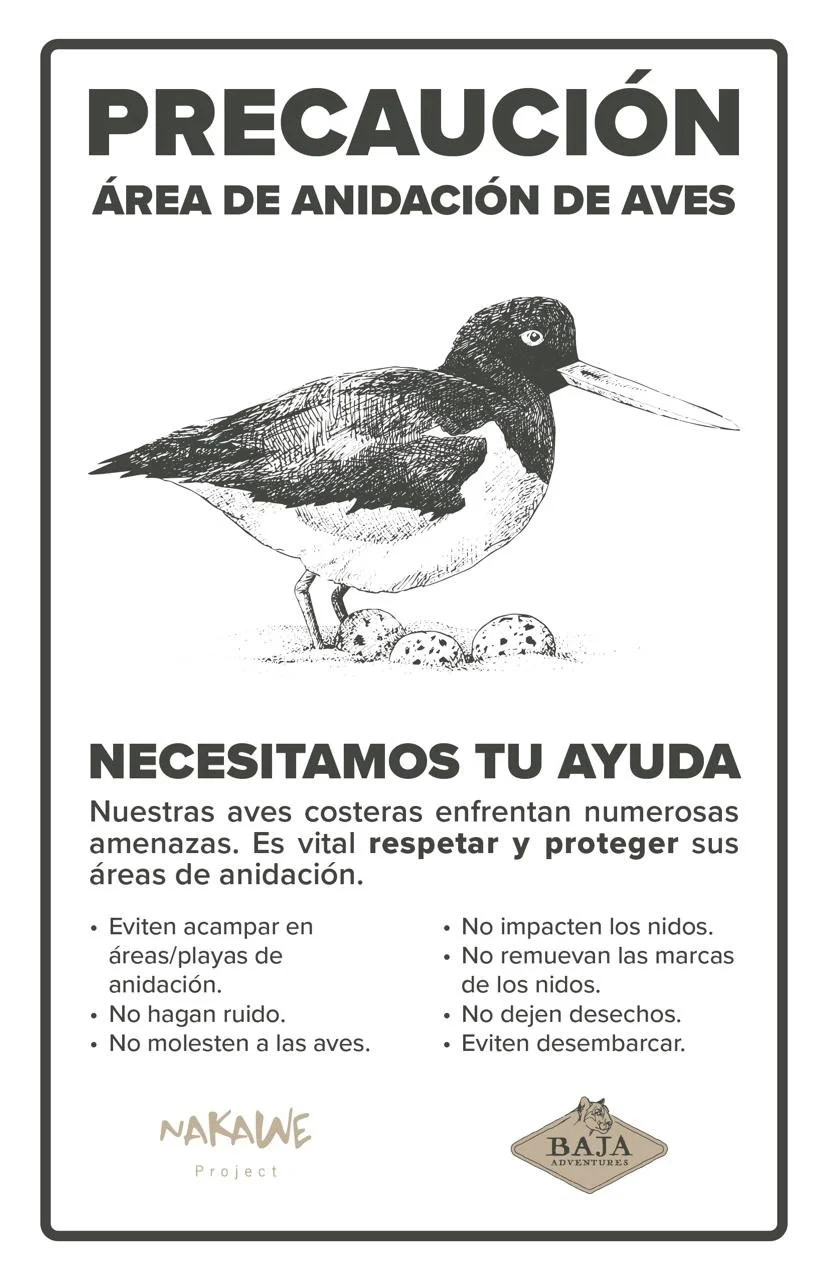Wings of hope: celebrating the triumph of the Piru-Piru (the American Oystercatcher) in Loreto National Park
The american oystercatcher and her chicks photographed by our expedition leader Regina Domingo
Along the wild, sun-drenched shores of Loreto National Park, a quiet miracle has unfolded, one that speaks to both the fragility and resilience of life on Mexico’s Pacific coast. This season, a nest of the American Oystercatcher (Haematopus palliatus frazari), affectionately known as the ‘‘piru-piru’’, has successfully fledged its chicks. For bird lovers, conservationists, and anyone who cherishes the natural wonders of Baja California Sur, this is a story worth celebrating—and protecting.
Meet the pacific pexican american oystercatcher
The piru piru is no ordinary shorebird. With its bold black-and-white plumage, long pink legs, and a bill as orange as a Baja sunset, it is a striking sight against the backdrop of sand and sea. But what truly sets this bird apart is its story: the Pacific Mexican American Oystercatcher is endemic to Mexico, meaning it exists nowhere else on Earth.
Sadly, this uniqueness comes with a price. The Mexican government lists the piru piru as “En Peligro de Extinción” (Endangered). Fewer than 3,000 individuals remain, scattered along the Pacific coast from Baja California to the Isthmus of Tehuantepec. In places like Bahía Santa María, Sinaloa, nearly a quarter of the world’s population gathers—a testament to how precious and vulnerable these habitats are.
Why are they in danger?
Despite their beauty and resilience, piru pirus face a daunting array of threats:
Habitat Loss: Coastal development and human encroachment steadily erode the wild beaches and tidal flats where oystercatchers nest and feed.
Disturbance: Vehicles, unleashed pets, and even well-meaning beachgoers can unknowingly cause adults to abandon their nests or chicks. A single disturbance can mean death by exposure or predation.
Predators: Introduced animals like coyotes and feral cats are a constant danger to eggs and chicks.
Genetic Threats: Hybridization with the Black Oystercatcher threatens the genetic uniqueness of the Mexican subspecies.
A nest’s journey: From egg to flight
American oystercatcher eggs on Carmen Island in Loreto bay national park
Between March and August, the piru piru’s nesting season unfolds in the open, often on bare sand or among scattered rocks. Their eggs, camouflaged to perfection, are vulnerable to every footstep and tire track. When the chicks hatch, they are tiny, downy, and utterly dependent on their parents. For 35 to 45 days, they cannot fly. If disturbed, the adults may flee, leaving their young defenseless against predators or the scorching sun.
Imagine: a single moment of carelessness—a dog off leash, a rock turned over, a family picnicking too close—can spell disaster for a whole generation of these rare birds.
The American oystercatcher incubating: A stunning photograph by our expedition leader Regina Domingo
Guardians of the shore: conservation in action
Hope is not lost. Across Mexico, organizations like CONANP, the Sonoran Joint Venture, and FONNOR are working tirelessly to protect the piru piru. Their efforts include:
Monitoring: Tracking numbers and nesting success at key sites like Bahía Santa María and Bahía de Ceuta.
Banding Programs: Studying survival and movement to guide future protection.
Community Education: Empowering locals and visitors to become stewards of their beaches.
But the most important guardian is you.
The American Oystercatcher incubating by our expedition leader Regina Domingo
How you can help: simple steps, lasting impact
If you visit Loreto National Park, or any coastal area where piru pirus nest, please remember:
Stay off nesting beaches from March to August. Respect signs and barriers.
Never approach chicks or nests. Chicks cannot fly for weeks, and disturbance can be fatal.
Keep pets leashed and away from shorebird habitats.
Leave no trace: Pack out all litter, and never move rocks or driftwood.
Share what you know: Tell others about the piru piru and why these beaches matter.
A shared future
The successful nesting of the piru piru in Loreto is more than a small victory for a rare bird—it’s a symbol of what’s possible when people and nature coexist with respect and care. By protecting these wild beaches, we ensure that future generations will hear the sharp, musical calls of the piru piru and witness the miracle of new life on the sand.
Let’s celebrate this triumph and commit to being guardians of the shore. The fate of the piru piru—and the wild beauty of Loreto—rests in our hands.
Join us in regenerative tourism and conservation
To deepen your connection with the piru piru and many other breathtaking species, we invite you to join one of our regenerative tourism expeditions in Loreto National Park. These immersive journeys combine adventure, science, and conservation, offering a unique chance to witness wildlife while actively contributing to their protection.
Since 2023, one of our dedicated local captains, Javier Martinez, has been an invaluable partner in this mission. Javier is not only a skilled and sensitive captain but also a passionate collaborator who provides us with daily reports on nesting couples, species sightings, and important events throughout the park. His commitment exemplifies how tourism, locals, conservationists, and artists can unite for a common cause. As Javier says:
“Working together, sharing knowledge and respect for the land and sea, we can protect incredible species and ensure their future. It’s not just about tourism—it’s about community and conservation hand in hand.”
Protecting Piru Piru nests: June 2024 Baja Adventures expedition with Captain Javier Martinez and participants
Last year, our dedicated team worked closely with local boat captains and crews, raising awareness about nesting sites along the beaches. We ran a successful social media campaign to educate locals on the importance of protecting the piru piru and their fragile nests.
One of our inspiring participants and talented artists, Jules Casol, created a beautiful illustration inspired by witnessing a piru-piru nest during one of our 2024 expeditions to the Loreto Islands. This artwork, born from direct experience and guided by our onboard photographer’s images, captures the delicate balance of life and threats these birds face.
Our volunteer, Guadalupe Ortiz from Nakawe Project, also helped design signs and banners to mark and protect nesting areas, demonstrating how community, art, science, and tourism come together in powerful teamwork.
2024 american oystercatcher nesting season campaign banner by Nakawe Project and Baja Adventures teams
Together, we make a difference
Protecting the piru-piru is a collective effort—one that thrives on collaboration between guides, scientists, artists, volunteers, local communities, and visitors like you. By joining our expeditions, you become part of this vital story, helping ensure that these enchanting birds continue to grace Mexico’s shores for generations to come.
Join us this summer on a journey that leaves a positive footprint, explore, learn, and protect with us in Loreto.
A family of American oystercatcher, by our expedition leader Regina Domingo
Discover more and book your regenerative expedition today with us at Baja Adventures, where every expedition supports conservation, community, and the wild heart of Loreto.







